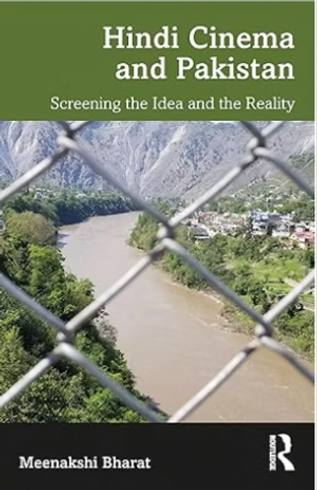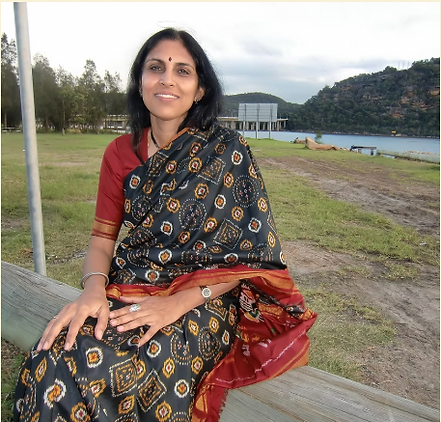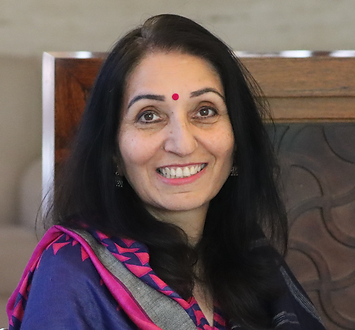TALKING BOOKS

Rachna Singh, Editor, The Wise Owl talks to Meenakshi Bharat about her book 'Hindi Cinema and Pakistan: Screening the Idea and Reality'

Talking Books
With Meenakshi Bharat
‘Framing the Neighbour: Pakistan in Hindi Cinema’
– A Conversation with Meenakshi Bharat”
Rachna Singh, Editor, The Wise Owl talks to Meenakshi Bharat—distinguished academic, author, translator, and critic—who has long been engaged with the cultural and political undercurrents of South Asia through literature and film. Her latest book, Hindi Cinema & Pakistan: Screening the Idea and the Reality, is a compelling multi-layered study that delves into the portrayals of Pakistan and Pakistanis in Hindi cinema since Partition. Drawing on over four decades of teaching and research in cultural and postcolonial studies, she offers an astute analysis of how popular films—from war dramas to rom-coms—have reflected and shaped India’s evolving relationship with its neighbour. In this interview, we discuss the cultural anxieties, cinematic tropes, and political narratives that have defined the “screened” imagination of Pakistan, and what that says about India’s perception of itself.
Thank you Meenakshi for taking time out of your busy schedule to talk with The Wise Owl about your recently released book Hindi Cinema & Pakistan: Screening the Idea and the Reality. This subject gains more relevance in the light of the current escalation of geo-political tensions.
RS: Your book takes on a vast and sensitive subject: the portrayal of Pakistan in Hindi cinema since 1947. What first drew you to explore this theme, and how did your background in cultural and postcolonial studies inform the lens through which you examined these films? Was there a personal or scholarly moment that triggered this exploration or did you see a gap in existing academic discourse on this subject?
MB: I think my interest in the persisting presence of Pakistan has subconsciously always had a place in my being. I am a post-Partition child and, therefore, never knew the space that became Pakistan first-hand. But as an ‘idea,’ I think it was always there to see, to feel—an absence that always made its presence felt: in the name of the village, Hardo Khanpur, that was occupied by my grandparents and the other villagers; in the beautiful little mosque that abutted their house; in the weekly films that I got to see, screened in remote locations where my father happened to be posted. Only, I did not ‘recognize’ this presence then.
It was only many years later that my training and experience in postcolonial and cultural studies compelled me to look at everything that I’d accepted unquestioningly as a child with fresh eyes. My early research on the child as the ultimate colony took me to the child in the Partition novel, and thence to the idea of Pakistan. When this combined with my love for cinema, it seemed natural to focus on understanding what this idea meant to me, to the subcontinent and the world.
RS: You talk about how Pakistan is often cast as both a “desirable other” and a “horrifying antagonist.” Could you walk us through how these seemingly contradictory portrayals coexist in mainstream cinema—and how these depictions have shifted over the decades?
MB: With lingering memories of lost connections and slipping roots, looking back at Pakistan as the ‘desirable other,’ with longing seems but natural. But, at the same time, ever since the initial holocaust in the Partition, the context of violence and antipathy accompanying all face-offs between the two nations, covert or open, has built up Pakistan as ‘the horrifying other.’ The most interesting and confounding reality is the continuing simultaneity of both these drives, sometimes even within the same individual. While at a personal level, an Indian may hanker for the other as a distant, lost beloved, as a citizen of the country, the Other is reviled as the enemy. This simultaneity has been mirrored in Hindi cinema almost from the beginning, sometimes begrudgingly, sometimes openly. Early Hindi cinema desisted from naming the enemy country, however obvious the reference was, the hesitation in itself hinting at a more positive underpinning. Thereafter, Hindi cinema, by and large, followed the thawing and hardening of the relationship at the political level, even as it endeavoured to give a nuanced take on the relationship. While propaganda films which generally came when the Indo-Pak relationship was at a low, were replete with anti-Pakistan, chest-thumping nationalist rhetoric (Border, Qayamat, Zameen, The Hero: Love Story of a Spy, to name a few), others attempted to give screen space to both the pulls, to a greater or lesser extent. Fortunately, this second type of film, too, has been constantly made, with even Roja, one of the first films on terrorism, made at a time when the relationship was at an unimaginable low, allowed the Pakistani terrorist his say. As time has passed, with increasing sophistication, the contrariness in the relationship has been plumbed sensitively in films like Raazi even as outright nationalistic films continue to be made.
RS: Your study encompasses a wide spectrum of film genres—from war epics and spy thrillers to films on cross-border romance and even comedic exchanges. What are the key differences in how these genres handle the ‘idea’ of Pakistan? Do these films manage to create space for empathy or reconciliation, or do they ultimately reinforce old tropes?
MB: I think more than the genre, it is the perspective of the filmmaker that makes for the difference in how films handle the ‘idea’ of Pakistan. So, though war films, spy thrillers and films on terrorism are the most likely to spout animosity in jingoistic enunciations since the format thrives on the drama emerging from the construction of enemies, adversaries and hostility, it is not a given that the Hindi films in these genres are antipathetic to Pakistan: Kabul Express has Indians and Pakistanis sharing cultural musings in their recalls of beauteous Kashmir and Madhuri Dikshit; a spy thriller like Raazi will allow for the birth of a warm, caring relationship between the protagonists from opposite sides even as each follows the directives issued from their national affiliations. War Chhod Na Yaar, an out-and-out war film, issues the strongest anti-war call by emphasizing the commonalities between the opposite sides and the friendships established across the fence despite the oppositional machinations of political bigwigs from both India and Pakistan. On the other hand, cross-border romances sometimes occasion the most strident portrayals of enmity, as in Gadar and Veer-Zaara. With the appearance of Tere Bin Laden, comedy became a fruitful way of exposing the ridiculousness of continuing hostilities and showing the way to a happy connection. It is worth noting that this Hindi film is wholly set in Pakistan and fields no Indian characters. And yet, how relatable the whole action is! So, Hindi cinema ultimately does create space for empathy, does highlight possibilities of reconciliation, even as other, nationalistically -driven chest thumpers reinforce old tropes.
RS: To what extent do you see historical and political events—like wars, Kargil, the Mumbai attacks, or peace talks—shaping the tone, content, and frequency of films about Pakistan? Do you think Hindi cinema is responding reactively to geopolitical climates, or does it have its own agenda in constructing the “other”?
MB: I think I may have already answered this question. Nonetheless, since this is so important, I will say this more directly. At times when the Indo-Pak relationship is at its most abysmal low, during war, or after terrorist attacks on Indian soil, on Indian nationals, nationalist films that clearly define Pakistan as the enemy are made. The recent flurry of war films, spy sagas and biopics on national heroes and martyrs (Uri: The Surgical Strike, Shershaah, Mission Majnu) bear out this point. Similarly, the political efforts of reconciliation are represented in films like Dil Bole Hadippa and Total Siyappa. But the key point is that though the politics of the subcontinent does give a spurt to one or the other kind of filmic portrayal, to increased stridency or maudlin overtures, responsible, alert filmmakers continue to seek possibilities. So, even when national tempers are running high and uber-patriotic films are being made, the middle ground is constantly being probed, and possibilities of reaching out are identified. And, even as films following the few-and-far-between thaws mount sentimental narratives, filmmakers keep in mind the latent tension.
RS: You describe cinema as both a mirror and a moulder of public perception. What impact do you believe these cinematic portrayals have had on generations of Indians? Can film, as a cultural product, carry subconscious or formative weight in shaping national identities and hostilities?
MB: As I have already indicated, films hold a mirror to the public mood and sentiment. At times, cinema has been co-opted to spout the nationalist line and thus tried to shape public national opinion. As the most popular medium of entertainment, these films with chauvinistic calls reach out to those already inclined to listen, supporting and encouraging following. Similarly, the identification and push to reconciliation have also impacted film production. So, cinema functions both as a mirror to, and as a director of public perception. What dogged cinematic portrayals of the India-Pakistan relationship—indicative of the subconsciously recognized centrality of the issue- have certainly done is to recognize this importance and ensured continued life to the Other in our cultural imagination.
RS: In the course of your research, were there any films that surprised you—either by challenging prevailing narratives or by presenting Pakistan or Pakistanis in unexpectedly nuanced ways? Were there moments of cinematic bravery or self-reflection that broke away from mainstream nationalist rhetoric?
MB: Oh, yes, Hindi cinema on the India-Pakistan theme has been throwing up surprises constantly! That’s what makes the body of output so meaningful. In breaking away from the prevailing political and public perception of Pakistan as the enemy, these films become the voice of breakaway sanity, as a fervent cultural appeal for recognizing the ties that bind the two countries together, whether it is politically expedient or not. So, when an uber-patriotic post-terrorist film like Roja allows the terrorist to speak for his ideology, or when a Tere Bin Laden refuses to speak either for or against either India or Pakistan even as it focuses on terrorism, or when war becomes an occasion not to say ‘Jai Ho’ but to puncture the ideology of war itself, to attack politicos from both sides in their pursuit of war for personal gain in War Chhod Na Yaar, that’s when Hindi cinema surprises me. Also, when a filmmaker dares to speak up for a minority community or section of society in an atmosphere of chauvinistic exclusionism. Happily, these examples of brave articulation in the face of mainstream nationalist rhetoric are numerous enough to warrant interest, enough to applaud as being, to quote Nikolas Kompridis, ‘possibility disclosing.’
RS: Your book speaks not just to film buffs or political analysts but to readers interested in the psychology of enmity and the media’s role in sustaining or dissolving it. What kinds of conversations do you hope the book sparks, particularly in educational or diplomatic circles?
MB: You have caught the pulse of the book exactly! I firmly believe that if there is a political will, the media can be co-opted in dissolving the perpetual enmity in which the two sibling-nations continue to dwell. It is eminently clear that the media have been deployed to fan the fire all the time, and unfortunately, it has either complied or been forced to comply with the mainstream directive. This book intends to start conversations about the possibilities of coming together, both among the youth and experts who understand the importance of amity in a fractious world.
RS: Finally, with today’s increasing polarization in both politics and media, do you think there is still space in mainstream Hindi cinema to reimagine the India-Pakistan relationship? Or are we moving toward more entrenched and homogenized depictions that leave little room for nuance?
MB: Historically, there have been wild oscillations in the degree of polarization in both politics and media in the Indian Subcontinent. It is true that entrenched and homogenized depictions continue to be made, and that they become more frequent when the tilt becomes more marked. But, even from the lowest of the lows of polarized spaces, mainstream Hindi cinema has been able to venture something new, something nuanced, balanced and humane. And it will continue to do so. That much faith I have in the possibilities of alert, creative engagement.
Thank you, Meenakshi, for talking with The Wise Owl about your book. We wish you the best in all your future scholarly & cultural endeavours.
About Meenakshi Bharat


Meenakshi Bharat is a distinguished academic, author, translator, and critic—who has long been engaged with the cultural and political undercurrents of South Asia through literature and film. Her latest book, Hindi Cinema & Pakistan: Screening the Idea and the Reality, is a compelling multi-layered study that delves into the portrayals of Pakistan and Pakistanis in Hindi cinema since Partition. Drawing on over four decades of teaching and research in cultural and postcolonial studies, she offers an astute analysis of how popular films—from war dramas to rom-coms—have reflected and shaped India’s evolving relationship with its neighbour
About Rachna Singh
